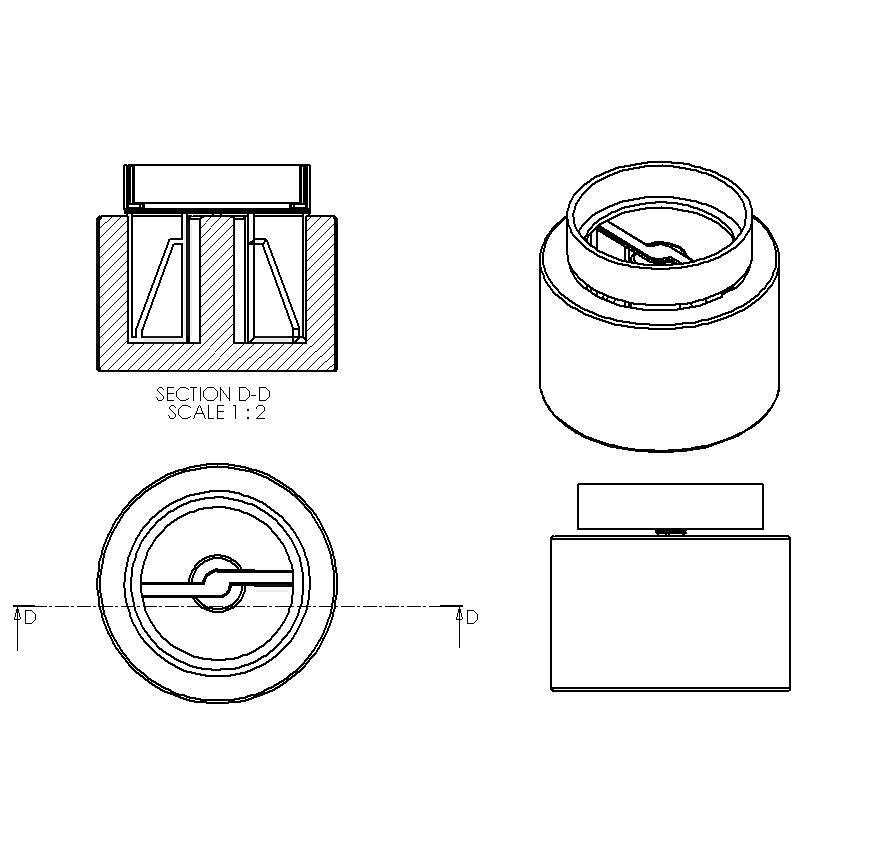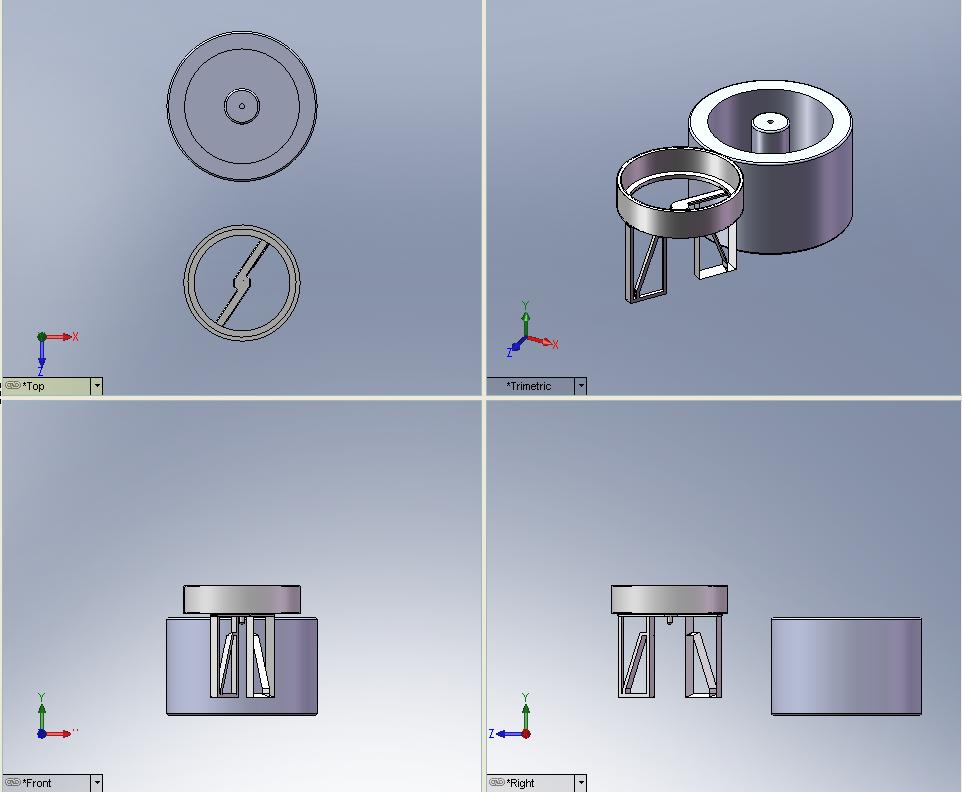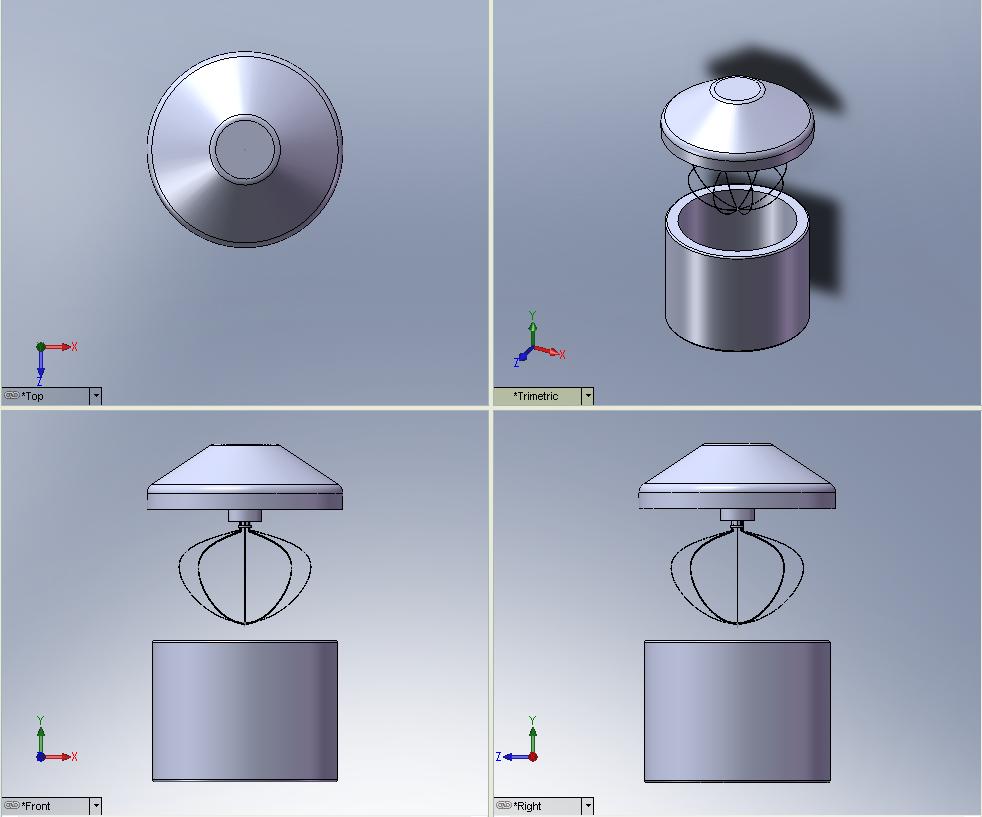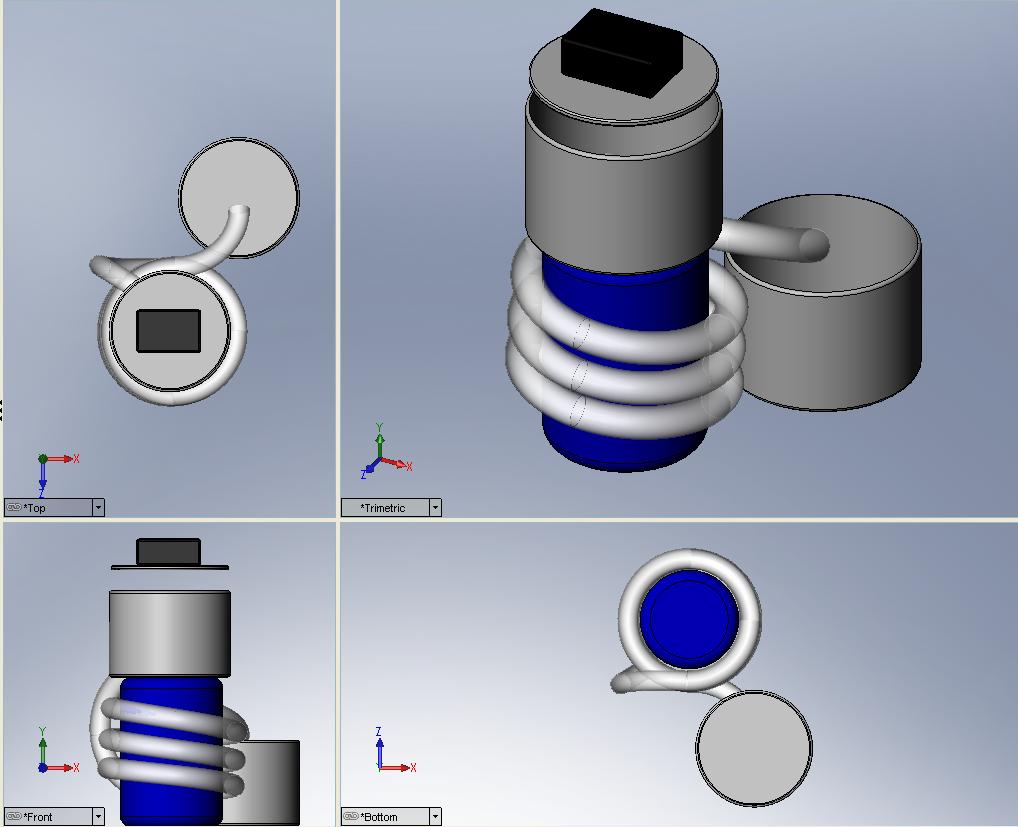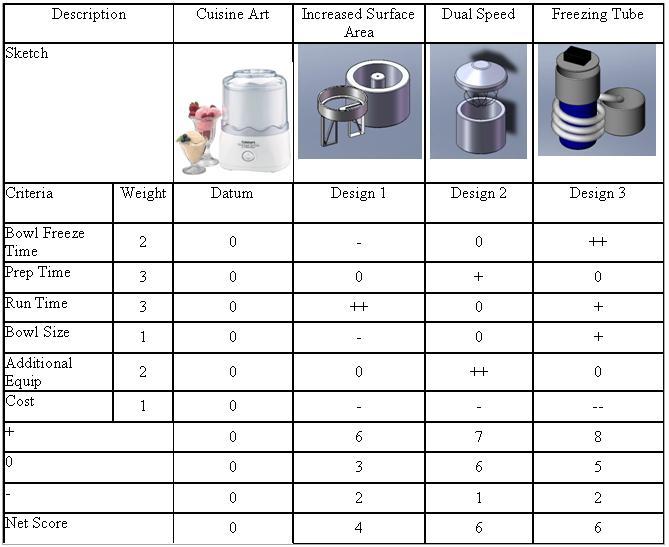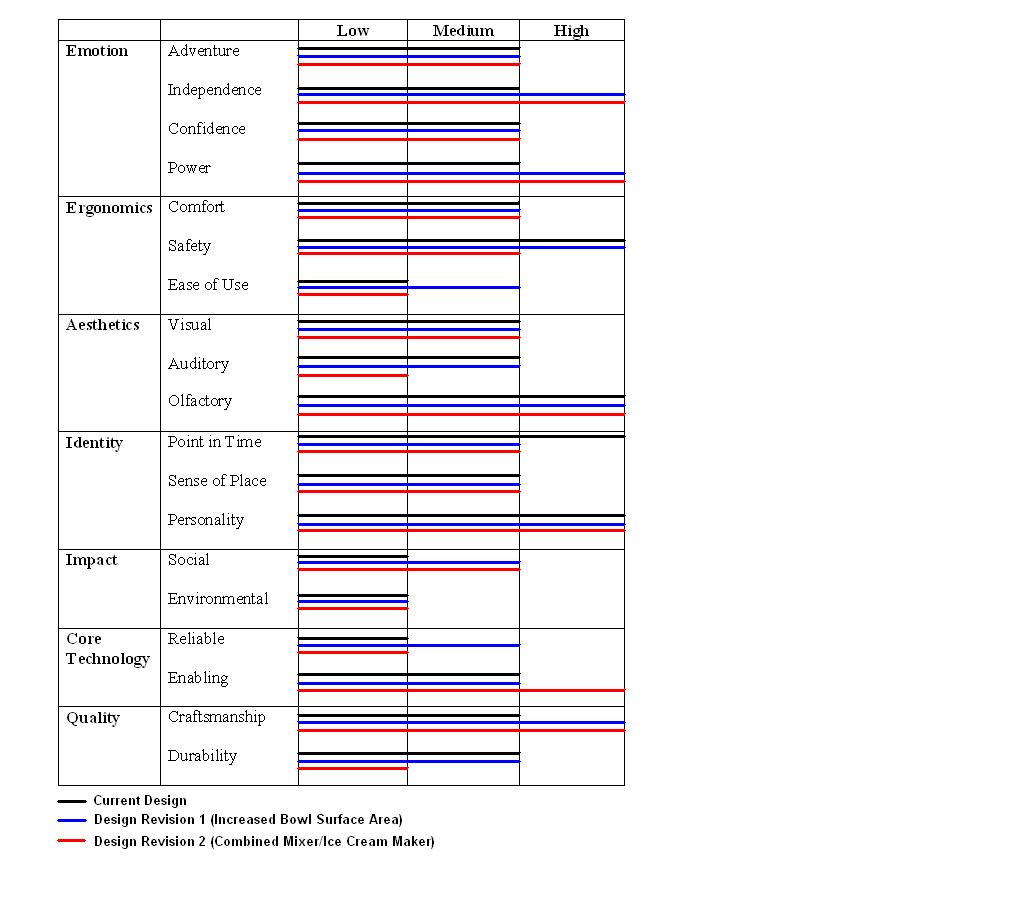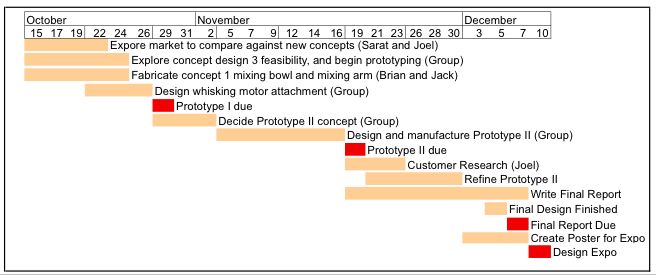Ice cream maker redesign
From DDL Wiki
(→Pugh Chart) |
(→Pugh Chart Conclusions) |
||
| Line 86: | Line 86: | ||
== Pugh Chart Conclusions == | == Pugh Chart Conclusions == | ||
| - | Clearly from the net scores, all three ideas are improvements on the datum. Design 2 and Design 3 both score the | + | Clearly from the net scores, all three ideas are improvements on the datum. Design 2 and Design 3 both score the highest with a score of six. However, it is possible to combine design 1 and 2 into a single product, which would receive an even high net score. Ultimately it will be up to our group to decide which idea is the most feasible and then move on from there. |
= Value Oppurtunity Analysis (VOA) = | = Value Oppurtunity Analysis (VOA) = | ||
Revision as of 14:30, 12 October 2007
Contents |
Executive Summary
Research and Observations
We have observed the ice cream maker in use and have noticed many processes that can be improved. The process that is currently used in today’s industry is a bit extensive and a consumer may grow tiresome of the long waiting process. In one of the trials, the users had to wait for approximately three hours before deciding to give up and put the mixed product into the freezer.
Our other trials were much more successful. The users were able to add the ingredients into the bowl and create ice cream in the advertised time. However, since there is extensive preparation time, this elongates the process of actually making ice cream. If you need to prepare the ingredients for an hour before placing them in the bowl, then the actual time needed to make ice cream becomes one and a half hours.
When observing the subjects interacting with the ice cream maker, it was evident that there was difficult with the clean up with the mixing arm. Since some of the spots were difficult to reach and the ice cream was sticking onto the arm, the cleaning of the mixing arm became frustrating. Also, since the mixing bowl is not dishwasher safe, this had to be cleaned manually.
Another observation that we observed is that the user has very little interaction with the actual device. Once the ingredients are properly mixed and prepared, then this is placed into the bowl and the user will turn the switch from the “Off” position to the “On” position. For a user to be able to produce all of the desired products (sorbet, sherbet, shushes, frozen drinks), they need the use of other products. The user has more interaction with other products, which include blenders, pots, pans, etc. Without these other products, it is not possible to make these other desserts.
Design Problem and Possible Solutions
The main problem that we would like to address is the excess preparation time. This includes the time it takes to prepare the ingredients to make ice cream along with the time required to leave the mixed ingredients in the mixing bowl. If we are able to significantly shorten this process, then the consumer will be able to enjoy their dessert without all of the waiting.
With the current process, if a consumer would like to enjoy dessert after dinner, they would have to prepare the ingredients before dinner and then make the ice cream while they eat dinner. This may not be optimal because the consumer is already preparing dinner, and adding another process may be confusing or stressful.
Some possible solutions to alleviate this problem are to redesign the bowl, redesign the process to make the ice cream, or to create a multi-functional bowl. The first solution, to redesign the bowl, is aimed to lower the preparation time of the ice cream after the ingredients have been mixed. This is aimed at lowering the half hour of mixing time that the bowl needs to make the ice cream. Since the bowl is freezing the ice cream as it is being made, if we increase the contact surface area, then there will be increased heat transfer between the walls of the bowl and the ice cream. We will have to do further research if the increased surface area significantly decreases the time required to make the ice cream.
The second possible solution is to create a multi-functional device that would incorporate the other processes in one appliance. This would shorten the cleaning up process because the consumer wouldn’t have to use other products such as a mixing bowl or blender. Our proposed solution is to include a dual speed motor with interchangeable whisking and mixing arm attachments that the user could switch based on need. The whisking arm would be in place for the preparation process and the mixing arm would be in place for ice cream making process. One major change from the current design is that the bowl itself would not rotate. Instead, the motor would rotate either the whisking or mixing arm. If we created an all-in-one device, the consumer would not have to clean the other devices after use, since only one container was used in the process.
The third possible solution is to redesign the process of making ice cream. The current process requires a bowl and some arm that is used to mix the ingredients to allow for consistency. A new process that would be able to expedite the process is to extrude the ice cream through a tube. The tube will have a small cross-section, and its wall will be cooled with a cooling mechanism. Then, the ingredients will be pushed through the tube until it forms into ice cream. Some research that needs to be done with this process will be the effectiveness of the tube. What will be the cross-sectional diameter of the tube? Depending on the cross-section, how long will the tube need to be to create the proper consistency of ice cream? Also, a major factor will be the length of time that is needed to make the ice cream. Will this new idea cut down the preparation time significantly? Lastly, cost will be a factor into this equation. Will the cost of this device be more expensive or cheaper? What parts will be used to make this redesign and how much will they cost?
Proposed Design Change 1
Increase Surface Area of the Freezer Bowl: An additional tube of the freezeing fluid that sticks up into the middle of the freezer bowl would expose more of the ice cream to a frozen surface of the bowl. It is obvious that the Ice Cream in the old design freezes unevenly, hardening faster at the edge of the bowl, then at the middle. This design chage requires a redesign of the mixing arm as well.
The design uses a similar geometry to the orginal mixing arm, but slimmed up and doubled. These dual arms are suspended on an added beam and then retained on a ring similar to the orginal. The new freezer bowl sits on the same base as the old one and rotates. The same Easy Lock Lid is used to hold the mixing arms in place. The added beam also has a pin in the center that the mixing arms rotate around.
Proposed Design Change 2
Combined Mixer/Ice Cream Maker: This design change requires several changes to the design. The motor must be position on top of the freezer bowl so that it can spin a whisking arm attackment. The whisking attachment clips into the motor with a spring loaded locking mechinism, similar to the one on common houshold electric mixers. The classic mixing arm from the old design is slightly altered to fit on to the locking mechinism as well. By adding a gear shift to the gear train that comes off the motor it can spin at two speeds. A fast speed to whisk the ingredience of the recipe together, and a slow speed to churn the ice cream. This desing also allows for a third blended attachment (not shown) that would blend ingredience as necessary for certian chocolate ice cream recipes.
The added whisking component ensures that additional air is whipped into the raw ice cream mix before it has a chance to freeze. The additional air in the ice cream mixture would add to the fluffy texture of the final ice cream.
Proposed Design Change 3
Freezing Tube: This design concept revolutionizes how ice cream maker have historically worked. In this concept the surface area of the ice cream exposed to the freezing unit is increased by running the ice cream through a tube that coild around between two freezing units. The outer caseing (not shown) and the inner (blue) cooling cylinder are both filled with either a 23% salt-water concentration, or a suitible cooling chemical that have a freezing point of around -20 degrees F.
The freezing tube device is used by pouring the room temperature ice cream mixture into the containter on the top. The liquid then runs down the device into the freezing tube. At this point a small compressor (about the size of an aquarium air pump) is engaged and starts pumping air into the system. The pumping both airates the ice cream mixtue and pushes it though the freezing tube, as the ice cream hardens. Agitators may be inserted into the freezing tube as well to aid in mixing the cream as it travels up the tube. The ice cream leaves the tube in a semi-hard soft serve state. It then falls into an ending cotainer that can be placed directly into the freezer for additional hardening.
Pugh Chart
A Pugh Chart, or design selection matrix is a useful tool for comparing several design concepts against each other. The key component is to compare several qualities of different concepts against a currently existing design, notated as the datum.
Pugh Chart Criteria
To first explain our Pugh Chart, we will give a description of the different criteria and weighting. Many of these criteria were used because they were identified as key improvement areas from our market research and brainstorming sessions
- Bowl Freeze Time - This is the time it takes for the freezing apparatus to freeze. In most cases this is the freeze time of the bowl, specifically the fluid inside. In the case of the third design, this would be the freeze time of the freezing element that the hose wraps around.
- Prep Time - Preparation time is a key element because it determines how much effort the user must put in before even using the ice cream making. Designs that reduce preparation time are the most desirable (hence a weight of 3) because it is the most cumbersome step for the user.
- Run Time - This is defined as the time that the product is running on its own, starting from pouring the prepared ingredients into the mixing apparatus to the time the ice cream is served. If the ice cream requires additional freezing in a freezer, this is part of the run time. Once again this is weighted strongly because it is the limiting step in the process, and the most important function of the ice cream maker itself.
- Bowl Size - This determines how much ice cream can be made in a single use. Products that allow for more ice cream to be made will receive higher scores. This received a low weighting because at the current time we do not know the bowl specification sizes of two of the products and therefor the final design may allow for the same amount of created ice cream as the datum.
- Additional Equipment - Users who buy an ice cream making will want to use a little additional equipment as possible because they already invested in the ice cream maker, and because more equipment means longer prep and clean up time. If the home ice cream making process can be streamlined into a single process with one device, then it will be very beneficial for users. Therefor, it receives moderate weighting.
- Cost - Ice cream makers are a luxury item, and therefor do not receive high weighting. Nevertheless, because all three design concepts require improvements and additional parts, it is important to note that the price in all likelihood will go increase.
Pugh Chart Analysis
- Design 1 receives high marks for run time because the increased surface areas means that the ice cream will freeze more quickly. Additionally, because more of the ice cream is in contact with the cold surface, the finished product will have a more uniform temperature. Design 1 receives low marks for freeze time because increased surface means more time to freeze. Additionally product room is sacrificed to increase surface area.
- Design 2 receives high marks for both prep time and additionally equipment because of its ability to streamline the ice cream making process. It allows for users to do all prep inside the bowl meaning less kitchen supplies and no transferring of mixtures. The design receives low marks only for cost because other than adding an additional component, all other aspects of the datum are kept the same.
- Design 3 receives high marks in several categories. Since there is no bowl to freeze, it receives high marks in this category. Since the tube allows for more freezing element contact, the run time is also decreased. Finally the process is now continuous, and there is no limit to how much cream can be made in one batch. However, this design is complex and as a result may see a large price increase.
Pugh Chart Conclusions
Clearly from the net scores, all three ideas are improvements on the datum. Design 2 and Design 3 both score the highest with a score of six. However, it is possible to combine design 1 and 2 into a single product, which would receive an even high net score. Ultimately it will be up to our group to decide which idea is the most feasible and then move on from there.
Value Oppurtunity Analysis (VOA)
A value opportunity analysis (VOA) of the ice cream maker designs described above can give valuable insight into what the user hopes to gain from using the product. By looking at the product designs from the user’s point of view, one can compare the worth of a new design compared to the existing base model. A VOA chart is broken down into seven main categories: Emotion, Ergonomics, Aesthetics, Identity, Impact, Core Technology, and Quality.
Each of these categories is further broken down into sub-categories which are rated from low to high for each design. We have limited the scope of our value opportunity analysis to only two of our three design concepts. The third design idea of using a pressure system to extrude ingredients through a chilled tube to make ice cream is not yet concrete enough at this point to proceed with a VOA. Further research needs to be done on this idea. The VOA chart below shows how the first two design concepts rate in comparison with the current base model that is out on the market. A further explanation of each category follows as well.
Emotion
Ice cream is a product that has a variety of flavors but consumers are usually dependent on professional ice cream parlors or restaurant to provide ice cream. Therefore, the biggest emotional impact that users can gain from an ice maker is that it allows them to be creative and independent in making their own ice cream. Both of the re-designs described in the VOA chart essentially allow the user to make ice cream more efficiently by saving time in some phase of the ice cream making process. This gives users more independence in that they don’t have to depend on as many extra components, such as a blender, and that they don’t have to spend as much time. Users also don’t have to depend on professional ice cream parlors for different flavors of ice cream, leading to a high level of independence. For this reason, we also feel that users will feel more empowered. The confidence and feeling of adventure the user will gain will be similar for the current design and both design concepts since the process of making ice cream and the quality of ice cream made will largely remain the same. Security and sensuality are also commonly used sub-categories in a VOA chart; however, they do not really apply to ice cream makers and have been omitted from this analysis.
Ergonomics
Since an ice cream maker is a very hands-on product, the ergonomics of it are very important to users. Ergonomics has been further broken down into comfort, safety, and ease of use. The comfort for all three designs analyzed is essentially the same since the user essentially interacts with the ice maker redesigns in the same fashion as in the base model. The on/off switch will remain the same, except in the case of re-design concept two, which will have a whisk/mix/off switch. However, the comfort of using the switch will be the same. The current ice cream maker on the market is quite safe since the mixing arm is made of plastic and there is a locking lid that makes it difficult to accidentally place body parts into the ice cream while it’s running. The design concept with the increased surface area bowl will have the same lid and also have a plastic mixing arm so the safety of the product has also been given a high rating. For design concept two, the whisking attachment will almost certainly be made of metal so it could be more unsafe. Furthermore, if the user accidentally bumps the on switch while interchanging components, safety issues could occur. For this reason, design three has been given a lower safety rating. For ease of use, the current design has been given a lower rating due to the additional components required to make ice cream. Although the ice cream maker itself is easy to use, the entire process can be quite frustrating at times. The second design concept is similar in that other components will be required, but it has been given a higher ease of use rating because the run time for the ice cream maker will be shorter. Design concept three removes the use of most additional components but can be confusing to use in that the user may have trouble deciding when to switch from whisking to mixing. Therefore, it has been given a low easy to use rating as well.
